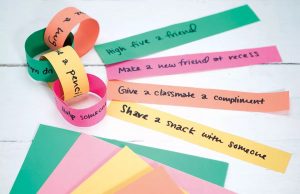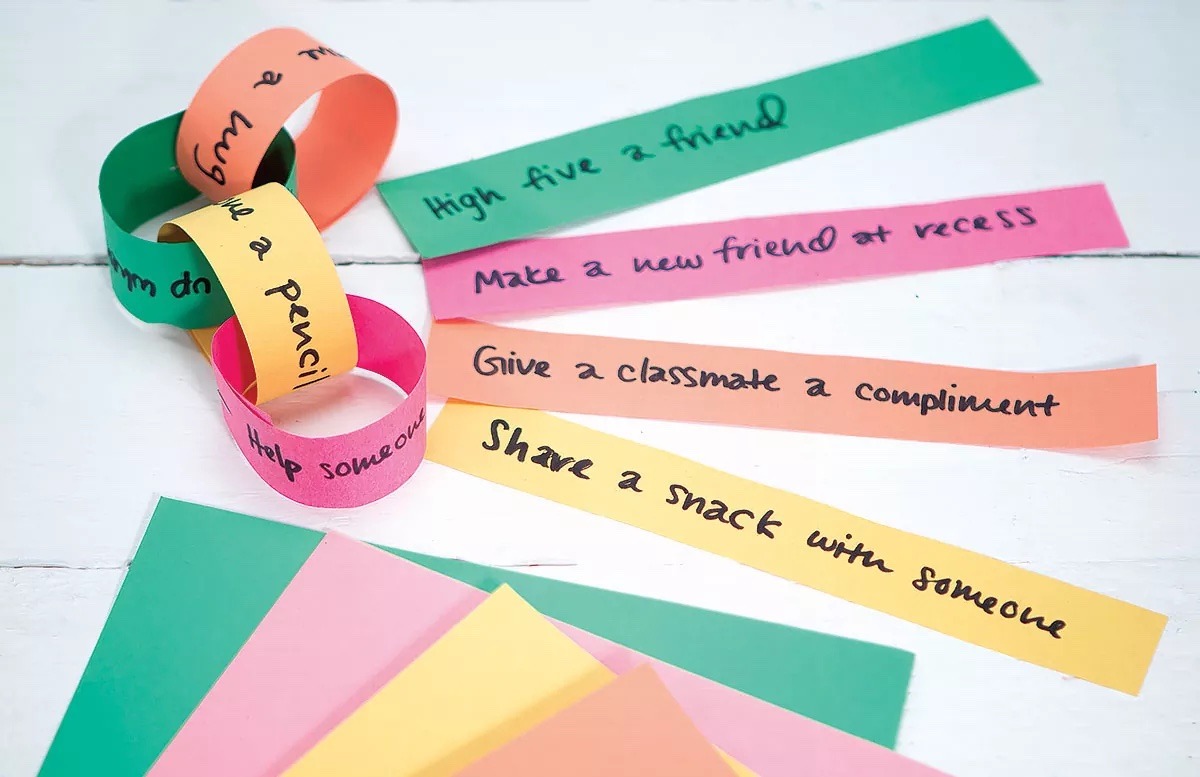Student Contributor: B. Manipakone
 The kindness chain is a way to represent all of the kindness the students have done throughout the year. Writing down all of the kindness the has spread in the classroom builds that community in the classroom as well as supports the spread of kindness.
The kindness chain is a way to represent all of the kindness the students have done throughout the year. Writing down all of the kindness the has spread in the classroom builds that community in the classroom as well as supports the spread of kindness.
The whole class has the opportunity to write a way to spread kindness in the classroom. Then after they write these ways, they are observed through the year and every time a student shows kindness, we will write it down and add it to our chain. This influences students to continue spreading kindness in the classroom and seeing what they wrote on how they could spread kindness will give them ideas on how to continue showing kindness. This support continues building the community in the classroom and supports students’ emotional needs by encouraging them and helping them understand that their peers are there to help.
This tool best fits in the supportive phase because it not only builds the community of the classroom but it also promotes inclusion. When students hear that other students got to put a link on the chain because of what they did to help a friend, this influences other students to follow. The teacher support student's effort to achieve these kindness goals and be helpful to their peers. This allows students to feel more comfortable in the classroom and having this positive language will let that comfortableness stay in the classroom. This also relates to the corrective phase as well because we can always refer back to what students said on how they can show kindness in the classroom when they are not being so kind. This will be using their advice and words to influence their behavior. The theory that this tool best relates to is collaborative and teacher-directed because students are given the responsibility to come up with ways to show kindness but the teacher still sets expectations and still maintains control of the chain link. The tool aligns to both by allowing students to come up with ways to be kind but also having the teacher observe and write down times students have been kind and added that to the chain.
More Information –
Tool Source: I got this idea from the website as well as my mentor teacher.



Overall, I felt like the kindness chain was very easy to prepare for and teach to the students. I noticed positive results within the students almost immediately. This was something that sparked excitement and community environment within our class. As time went on within using the kindness chain, I noticed students showing kindness more and more. Along with this I also noticed students showing kindness without using the “reward” of putting the chain up, they were just showing kindness just because! Something that could be added to this would be to change the chain task every so often. For example, the next week we are going to be putting a chain up for showing hard work in the classroom. Looking at this tool I feel like the students new their roll for this task, and it created a fun-loving classroom environment. I think it would be awesome to continue doing this and hopefully have it fill the entire room at the end of the year!
I tested this tool in a first-grade classroom with 20 students in a suburban community. The school that I am in has a school-wide kindness chain that is so long, it travels down hallways. Even though the school already had a kindness chain implemented for everyone, I decided I wanted to create a kindness chain just for our classroom. The main reason I thought this was a good idea was because how excited students were about the school-wide chain. I thought that having a chain within their classroom that they can see all the time would be even more engaging and beneficial. Because the kindness chain was already used in the school, it was very easy to teach to my students. I did like the aspect suggested in this post about starting the chain by having each student write one way to be kind. This was a really wonderful classroom discussion to have together, as students brainstormed ways to be a good friend, classmate, and student. In the following days after initially making the chain, the students were eager to add to it. One aspect that me and my mentor teacher added was that students were able to observe their peers acts of kindness to add them to the chain, instead of having this as solely the teacher’s role. I believe this encouraged students to participate more actively in being kind and appreciating their friends for being kind. After a while, we did have to remind the students more frequently about the kindness chain and encourage them to continue to participate. Overall, I love this tool. I think it’s great for the age-range specified in this post, but could also be used in a more meaningful way with older students.
I really enjoyed doing the Kindness Chain. I did this with my 5th graders during the month of February, whose character trait was kindness. I did this as a whole class activity, 24 students and this was in a more rural school district. This was a very easy tool to teach, prepare, and use. The students were very aware of their role with the new tool and it was a fun activity for them to do in general. I think that this went really well because I was with older students and they could cut their paper strips out. I feel if doing this with little kids, this would be a hard thing to do as you would have to have pre-cut the strips. I think something that could make it even better would be to start this at the very beginning of the year and add to it either every week or every month and see how long it would grow throughout the whole school year.